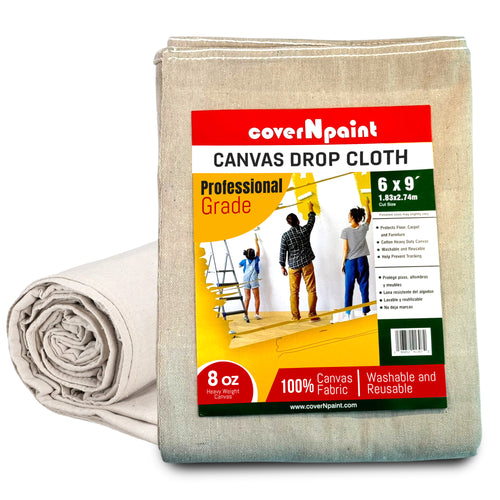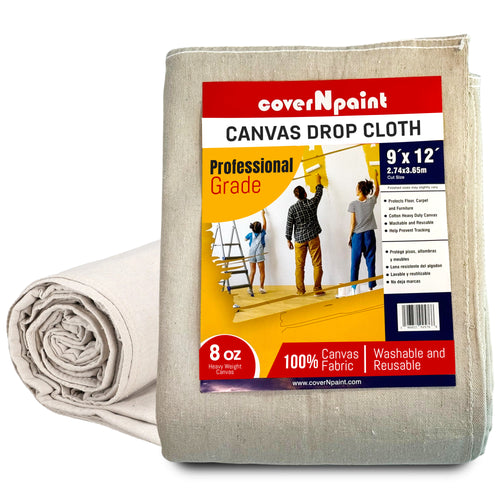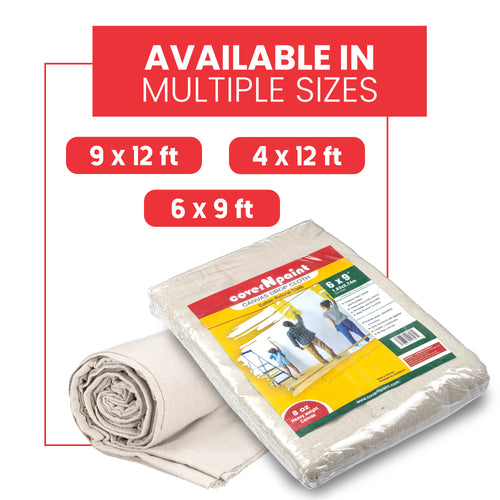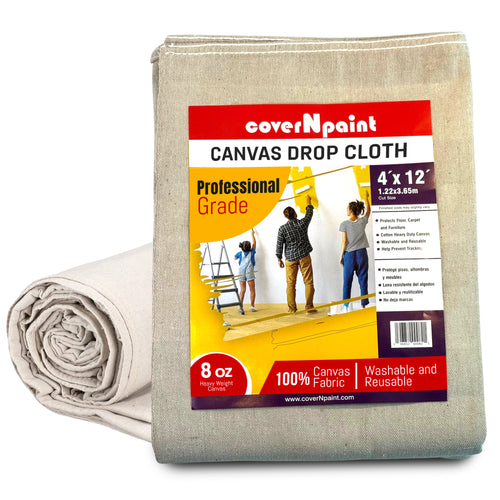Painting projects, whether professional or DIY, require careful preparation to protect both surfaces and people. Painters drop cloths are essential tools for covering floors, furniture, and countertops, but they can also introduce safety risks if not used correctly. Slips, trips, and paint stains are common hazards that can be avoided with proper precautions and expert techniques. Understanding the right ways to use canvas drop cloths and other types of paint drop cloths can make your painting projects safer and more efficient.
Why Safety Matters When Using Drop Cloths
While drop cloths are designed to protect your surfaces, improperly positioned cloths can become a hazard. A shift in a slippery plastic sheet or a wrinkled canvas can cause falls, while paint soaking through cheap cloths can damage floors. Safety is not just about protecting your workspace—it’s about preventing injuries, saving cleanup time, and maintaining productivity during painting projects.
Pro Tip: Investing in high-quality painters drop cloths like canvas options minimizes risks and enhances protection.
Types of Painters Drop Cloths and Their Safety Profiles
Different materials have unique properties that affect safety:
-
Canvas Drop Cloths: Thick, absorbent, and slip-resistant when laid flat. Ideal for hardwood, tile, or carpeted surfaces.
-
Plastic Drop Cloths: Lightweight but prone to sliding, which increases the risk of slips. Better for temporary or small projects.
-
Paper Drop Cloths: Useful for minor tasks but can tear easily and are not slip-resistant.
-
Synthetic Blends: Offer moderate protection with some slip resistance; suitable for medium-sized projects.
Knowing the right material for your project reduces hazards and ensures maximum protection for both surfaces and people.
Common Risks with Drop Cloths
Even experienced painters can face these challenges:
-
Slips and falls: Lightweight or wrinkled cloths can slide on smooth floors.
-
Trips and tangles: Loose edges or folds create tripping hazards.
-
Paint stains: Thin or low-quality cloths allow paint to seep through.
-
Damage to surfaces: Plastic or paper cloths may move, exposing floors to drips.
Understanding these risks helps you proactively prevent accidents.
Painters Drop Cloth Safety Tips
Here are practical tips to prevent slips, trips, and stains during your painting projects:
1. Choose the Right Drop Cloth Material
Opt for canvas drop cloths for heavy-duty projects. Their thick, woven fibers absorb paint and provide friction, reducing slips. For lighter projects, a synthetic blend may suffice, but avoid thin plastic sheets on smooth floors.
2. Secure Edges and Corners
Use painter’s tape or weights to anchor the edges of your paint drop cloth. This prevents clothes from sliding and creating tripping hazards, especially in high-traffic areas.
3. Keep the Cloth Flat and Wrinkle-Free
Wrinkles or folds in drop cloths can collect paint and create uneven surfaces. Smooth out the cloth before starting your project and check periodically during painting to maintain safety.
4. Layer for Maximum Protection
In areas prone to heavy spills, layering painters drop cloth adds extra absorption and stability. This is especially useful for hardwood floors or carpeted areas where paint can cause permanent damage.
5. Pre-Wash Canvas Drop Cloths
Washing new canvas drop cloths removes loose fibers that can make surfaces slippery. Pre-washed cloths absorb paint better and reduce the risk of slipping due to debris.
6. Monitor and Clean Spills Immediately
Even with a high-quality paint drop cloth, accidents can happen. Clean any spilled paint promptly to prevent slippery spots, and avoid walking over wet paint areas.
7. Fold and Store Properly After Use
Proper storage prevents mold, mildew, and damage. Fold canvas drop cloths neatly, keep them dry, and store in a cool area. This preserves their integrity and safety for future projects.
Painters Drop Cloths and Workspace Organization
A well-organized workspace reduces accidents. Keep all drop cloths, tools, and paint supplies in designated areas. Avoid cluttered floors, which can interfere with the stability of your drop cloths.
Expert Insight: Professionals often place heavier items like ladders or paint trays on drop cloths to anchor them, increasing friction and minimizing slip risks.
Industry Update: Eco-Friendly Drop Cloths
Recent trends in the painting industry emphasize sustainability. Eco-friendly canvas drop cloths are not only reusable but also reduce environmental impact. They provide the same or better protection than single-use plastic sheets, making them a safer and greener option. Learn more about these benefits in Eco-Friendly Advantages of Using a Canvas Painters Drop Cloth in 2025.
A Curiosity-Building Note
Many painters overlook simple adjustments that can drastically improve safety. Even minor tweaks in folding, layering, or anchoring canvas drop cloths can prevent slips and trips while saving time and money. Following expert techniques from coverNpaint USA ensures your painting projects are both safe and efficient, whether you are a DIY enthusiast or a professional contractor.
FAQs
Q1: Can canvas drop cloths prevent all slips and spills?
Canvas drop cloths significantly reduce risks, but proper placement, anchoring, and cleaning are essential for maximum safety.
Q2: Are plastic drop cloths safe for hardwood floors?
Plastic sheets can slide and are less absorbent. For hardwood, canvas drop cloths are safer and more effective.
Q3: How do I secure a drop cloth in high-traffic areas?
Use painter’s tape on edges, weights on corners, and layer multiple cloths if needed to prevent slipping.
Q4: Can painters drop cloths be reused safely?
Yes, especially canvas drop cloths. Clean and dry them properly before storage to maintain safety and performance.
Q5: What’s the best way to prevent paint stains under a drop cloth?
Choose a high-quality canvas drop cloth, layer in heavy-drip areas, and clean spills immediately to protect surfaces.













